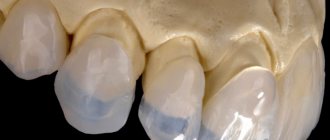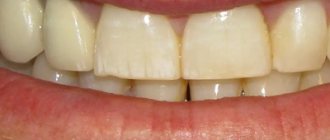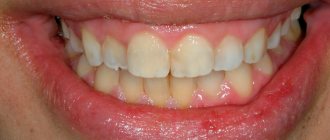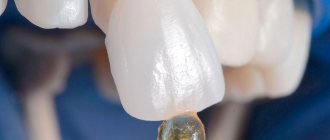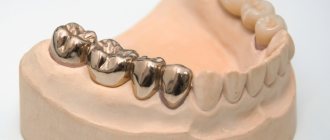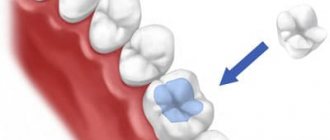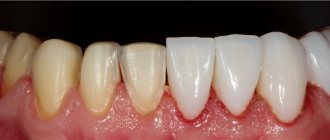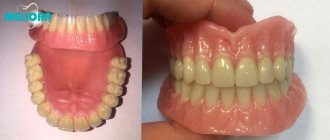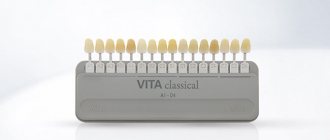Indications for the installation of porcelain crowns
The main indication for the installation of porcelain crowns is the aesthetic restoration of the front teeth:
· wedge-shaped defects and chips that cannot be eliminated using filling material;
Complete destruction of the dental crown;
· enamel hypoplasia;
Abnormalities in tooth color or shape;
· a pronounced change in the shade of tooth enamel that cannot be corrected using professional hygiene methods.
In addition, such designs are suitable for patients who are allergic to metal.
Is placement on the front teeth the best option from an aesthetic point of view?
Defects in the frontal dental region are always striking, causing discomfort to a person. The difference in the color scheme of the prosthesis in relation to your own enamel looks unaesthetic. By using ceramic products, maximum similarity of the shade of the structure with the natural color of the enamel is achieved.
Thanks to these qualities, the smile looks natural; it is almost impossible to distinguish the prosthetic area from the untouched one. Therefore, porcelain products today are one of the most popular ways to restore the frontal region.
Stages of manufacturing and installation of porcelain crowns
First of all, at the appointment, the dentist examines the patient’s oral cavity, identifies possible contraindications, and, if necessary, carries out a complete sanitation. Only after this can you proceed to the next stage - preparing the tooth for a porcelain crown and selecting the optimal shade for the future design using a special template.
Next, the doctor takes a combined impression of the tooth and the entire dentition. And if the quality of the casts is satisfactory, it is sent to a dental laboratory, where a plaster model is made based on them.
Direct production of a porcelain crown can be carried out in two ways. The first involves layer-by-layer application of porcelain substance, and the second uses injection molding technology. It is the second option that is more modern and gives the structure high strength,
Therefore, it is used in most dental laboratories.
After the impression falls into the hands of a specialist, he uses thin platinum foil to create a mold for the future dental crown and fills it with a porcelain composition, and then exposes it to high temperatures several times.
The final stage of making a porcelain crown is the correction of the structure, its staining and glazing.
After the crown is ready, it is first tried on. If the result suits both the doctor and the patient, it is finally fixed on the previously prepared tooth.
The service is provided
Sharmay Oleg Nikolaevich Orthopedics, chief physician of the clinic
Branch: Pavshinsky, 17
Make an appointment with a specialist
Zohiri Khoja Zakirovich Therapy, orthopedics
Branch: Pavshinsky, 17
Make an appointment with a specialist
Benefits of porcelain crowns
· High aesthetics. Porcelain has almost ideal optical characteristics. It very accurately conveys the natural shade and translucency that are characteristic of natural tooth enamel.
· Hypoallergenic design and inert material. Porcelain does not have thermal conductivity, so tooth sensitivity to temperature changes is reduced. Since the crown does not contain a single gram of metal, it can be installed in patients who are allergic to it.
· Long service life. With proper care, the structure will last a very long time, approximately 10-15 years, without losing its performance characteristics.
· Resistant to staining and darkening. Porcelain crowns do not lose their shade and shine, maintaining their original appearance for a long time.
· Minimum adaptation time. The patient quickly gets used to the lightweight and comfortable design.
· Easy to care for. Crowns do not require special care. It is enough to use a high-quality toothbrush and toothpaste, and treat them with care.
How long will they last?
On average, the lifespan of porcelain crowns ranges from 10 to 15 years. Thanks to the use of the latest technologies in their production, they are very attractive and at the same time durable.
But patient habits can shorten the service life of such products. They will last less for people who prefer hard foods and who clench their teeth hard. In this case, premature defects (cracks and chips) may occur. And even a small crack can quickly grow throughout the entire porcelain product, rendering it unusable.
For this reason, it is important for the “carrier” of porcelain crowns to follow all the specialist’s recommendations. It is better to exclude from the diet or significantly reduce the consumption of solid foods such as crackers and nuts. With such precautions, the crowns will last much longer than the stated period.
Disadvantages of porcelain crowns
· High cost of construction. It is due to the complexity of technical work, which requires very high professionalism from a specialist.
· Relative fragility of the material. Patients have to avoid eating solid foods.
· Restrictions on indications. Porcelain crowns are not placed on all teeth.
· Manufacturing of single crowns only. Porcelain is not suitable for creating and installing bridges.
Care instructions
Everyone knows that proper daily dental care is the basis of health. However, after installing porcelain products, you need to take more careful care of your oral cavity. To increase the service life of crowns, you need to follow some recommendations:
- Do not place excessive pressure on the prosthesis.
- If possible, avoid eating solid and tough foods.
- Providing quality oral care - brushing your teeth 2 times a day, rinsing your mouth after snacks with still water or mouthwash, and cleaning in between with dental floss.
- All hygiene products must be selected by a doctor.
- Carry out dental cleanings annually.
- Visit a specialist twice a year for a preventive examination.
Today, porcelain crowns are the most popular prosthetic products, despite their high price. Most people prefer not to save on their teeth, installing structures made from quality materials. With proper care and following the advice of specialists, dentures will serve their owners for a very long time.
Varieties of porcelain designs
Dental porcelain is an excellent material that provides ample opportunities for aesthetic restoration. Several types of structures are made from it:
· Veneers. These are thin plates designed to hide minor defects in tooth enamel. They cover only the front surface of the tooth. Porcelain, composite or zirconium dioxide can be used in their manufacturing process.
· Tabs. These are microprostheses made in a dental laboratory. They help solve more serious dental problems with teeth and are used, for example, in cases of severe decay of the crown or the presence of a large carious cavity.
· Crowns. The most versatile design that allows you to achieve a “Hollywood” smile. They are installed on the front teeth during aesthetic restoration.
Current promotions!
Implantation in installments regularly
The promotion operates regularly and applies to patients who require implantation.
Dental prosthetics is a necessary procedure that absolutely all people face, some earlier, others later. If you undergo treatment in a timely manner, regularly perform professional hygiene, and also follow the dentist’s recommendations, this moment can be postponed as much as possible.
All prosthetics in dentistry can be divided into removable and non-removable. Crowns are the most common way to extend the life of teeth, slow down the process of their destruction, and also an opportunity to save a tooth in case of injury, destruction or abrasion.
Anatomically, a tooth consists of a root (the invisible part located in the bone) and a crown part, which is located in the mouth above the gum level. A dental crown is a structure that is a cap that is placed on a previously prepared (ground) tooth. It protects the crown of the tooth from further destruction, and also allows the tooth to fully cope with the chewing load.
Metal ceramics or porcelain: what to choose?
This question arises among patients quite often. After all, each design has its own advantages and disadvantages. Thus, metal ceramics are distinguished by their high strength and affordable price, and porcelain has excellent aesthetic characteristics. Typically, the choice between them depends on which tooth needs to be restored. Crowns made of metal-ceramics are most often installed on chewing teeth, and porcelain crowns are installed on incisors and canines. However, if a porcelain crown has a zirconia framework, it can be used to restore any tooth.
Pressed ceramics
An advantageous feature of this type is the increased strength imparted during manufacturing. Ceramic dental bridges are produced under high pressure under vacuum conditions. Such products have a number of advantages:
- Does not require a metal frame.
- Minimal traumatic treatment of the prosthetic area before installation.
- Lightness of design.
- Increased wear resistance.
- Does not require mandatory “killing” of the pulp.
Flaws:
- Cannot be used to create long bridges.
- Not installed on side surfaces.
- Production requires highly qualified manufacturers and specific technical equipment.
This is how the shade of the material is selected to match the color of the patient’s teeth.
Kinds
Based on how the crowns will be attached to the base, they are divided into classes:
- Diatoric.
- Crampons.
The first group of structures are hollow inside products , fixed to the base with dental cement. Often because of this they are also called perforated. Typically used to restore lateral teeth.
The second group includes crowns that have a crown - an element that fixes an artificial unit , made of metal wire.
Most often, the material for wire is palladium or silver, since the thermal expansion coefficient of these metals is close to the properties of porcelain when fired. Crampon crowns are usually placed in the frontal area of the mouth.
Contraindications
It is not recommended to install porcelain if, upon examination of the oral cavity by a doctor, the following conditions are discovered:
- severe malocclusion;
- softness of dental bone tissue;
- periodontal disease in a chronic progressive form;
- acute inflammatory pathologies;
- absence of a large number of teeth.
All of the above restrictions are absolute and are due to the fact that porcelain, having sufficient hardness, practically does not wear off.
This usually leads to functional overload of the periodontal teeth-supports or worsens the course of existing pathologies.
Relative restrictions are:
- strong abrasion of enamel;
- bruxism (parafunction of the masticatory muscle group);
- anomaly of occlusion associated with deep overlap of the incisors;
- “living” pulp tissue of the mandibular incisors.
Important! Elimination of all these contraindications by carrying out treatment appropriate to the diagnosis creates favorable conditions for prosthetics using porcelain structures.
Price
The price of porcelain crowns, as in all cases of dental treatment, is determined by the status of the clinic and the qualifications of the attending physician.
But the prosthetics option itself can hardly be called budgetary due to the high cost of equipment and material for manufacturing the structure.
Therefore, most often this service is found in the VIP service section. Thus, the price for one unit can vary between 15-30 thousand rubles.
Don’t think that you can save money by choosing an alternative option – porcelain coating.
Despite the fact that such structures are made using the direct method in the dentist’s chair, their cost in some clinics is slightly higher than for the crowns themselves, because we are talking about veneers.
Moreover, they are significantly inferior in strength to solid structures. Yes, and they have a completely different list of indications.
